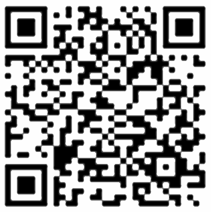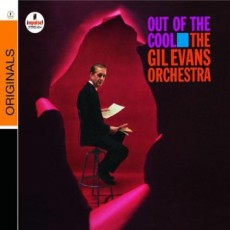
Daily Dose Of Jazz…
Gil Evans came into this world on May 13, 1912 in Toronto, Ontario, Canada as Ian Ernest Gilmore Green. His name was changed to his stepfather’s Evans early in his life. His family moved to Stockton, California where he spent most of his youth.
Between 1941 and 1948, Evans worked as an arranger for the Claude Thornhill Orchestra. His basement apartment behind a New York City Chinese laundry became a meeting place for musicians looking to develop new musical styles outside of the dominant bebop style of the day that included the leading bebop performer Charlie Parker, Gerry Mulligan and John Carisi.
In 1948, Gil collaborated with Miles Davis, Mulligan and others to create a nonet utilizing French horns and tubas keeping the big sound with less cost. The Davis-led group was booked for a week at the Royal Roost as an intermission group on the bill with the Count Basie Orchestra. Subsequently, Capitol Records recorded 12 numbers at three sessions in 1949 and 1950 that were reissued on the 1957 Miles Davis LP titled Birth Of The Cool. He was also instrumental in contributing behind the scenes to Davis’ classic quintet albums of the 1960s.
From 1957 onwards Evans recorded albums under his own name. He brought tubist Bill Barber, trumpeter Louis Mucci along with im and featured soloists Lee Konitz, Jimmy Cleveland, Steve Lacy, Johnny Coles and Cannonball Adderley. By 1965 he was arranging the big band tracks on Kenny Burrell’s Guitar Forms album.
Evans’ influence by Latin, Brazilian and Spanish composers Manuel de Falla and Joaquin Rodrigo as well as German expat Kurt Weill led him to create arrangements that included two basses, using Richard Davis, Paul Chambers, Ron Carter, Ben Tucker and Milt Hinton on many of his recordings. He was prolific in his recording until he became discouraged by the commercial direction Verve Records was taking with his arrangements for Astrud Gilberto’s Look To The Rainbow, causing him to take a hiatus from music.
During this period he began listening to Jimi Hendrix at the suggestion of his wife. He became interested in scoring the music of the rock guitarist, put together another orchestra in the Seventies and began working with in the free jazz and jazz rock idioms. He eventually released an album of arrangements of Hendrix’s music with John Abercrombie and RyoKawasaki and his ensembles featured electric guitars and basses, like that of Jaco Pastorious, from that date forward.
He would go on to release Where Flamingos Fly in 1981 with Coles, Harry Lookofsky, Richard Davis and Jimmy Knepper, Howard Johnson, Don Preston and Billy Harper. He created his Monday Night Orchestra in 1983 that became a staple for five years at Sweet Basil Jazz Club in Greenwich Village. Members of the band were Lew Soloff, Hiram Bullock, David Sanborn, Mark Eagan and Tom “Bones” Malone and Gil Goldstein among others. He recorded a big band album of The Police songs with Sting collaborating with apprentice arranger Maria Schneider.
Gil won two Grammy awards, has four films to his credit and was inducted into the Down Beat Jazz Hall of Fame in 1986. He ha a catalogue of eighteen studio albums, 16 live albums, arranged fifteen albums for Miles Davis, Hal McKusick, Helen Merrill, Johnny Mathis, Macy Lutes, Don Elliott, Astrud Gilberto and Kenny Burrell.
Pianist, composer, arranger and bandleader Gil Evans, who played an important part in the development of cool, modal, free and fusion styles of jazz, passed away of peritonitis in Cuernavaca, Mexico at the age of 75 on March 20, 1988.
![]()
More Posts: piano

Daily Dose Of Jazz…
John Martin Tchicai was born on April 28, 1936 in Copenhagen, Denmark to a Danish mother and a Congolese father. The family moved to Aarhus where he studied violin in his youth, but in his mid-teens began playing clarinet and alto saxophone, focusing on the latter. By the late 1950s he was travelling around northern Europe, playing with many musicians.
A move to New York City in 1963, found Tchicai joining Archie Shepp’s New York Contemporary Five and the New York Art Quartet. He played on John Coltrane’s Ascension album and Albert Ayler’s New York Eye and Ear Control, both influential free jazz recordings. Following his work in New York, he returned to Denmark in 1966, and shortly thereafter focused most of his time on music education.
John formed the small orchestra Cadentia Nova Danica with Danish and other European musicians, collaborating with Musica Elletronica Viva and performed in multi-media events. He was a founding member of the Amsterdam’s Instant Composers Pool in 1968, and in 1969 took part in the recording of John Lennon’s Unfinished Music No. 2: Life with the Lions.
On August 30, 1975, his appearance at the Willisau Jazz Festival was recorded with Swiss pianist Irène Schweizer and released later that year as Willi The Pig. Tchicai returned to a regular gigging and recording schedule in the late 1970s. In the early 1980s he switched to the tenor saxophone as his primary instrument. In 1990 he was awarded a lifetime grant from the Danish Ministry of Culture.[3]
Tchicai relocated to Davis, California in 1991, where he led several ensembles. He was awarded a National Endowment for the Arts fellowship in 1997, was a member of Henry Kaiser and Wadada Leo Smith’s Yo Miles band, a loose aggregation of musicians exploring Miles Davis’ electric period.
In 2001 he returned to Europe to live near Perpignan in southern France. On June 11, 2012, free jazz alto and tenor saxophonist and composer John Tchicai suffered a brain hemorrhage in an airport in Barcelona, Spain. While recovering he passed away on October 8, 2012, aged 76.
![]()
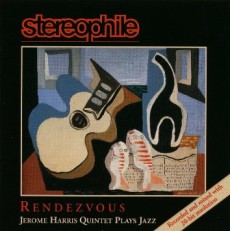
Daily Dose Of Jazz…
Jerome Harris was born April 5, 1953 in Flushing, New York and was already a skilled musician by the time he entered Harvard University with the intent of becoming a psychiatrist. During his college years he became known as a guitarist on campus who played in a variety of bands, from R&B to free jazz, including a fusion band with fellow student, drummer Akira Tana.
After graduation he decided to focus on music full-time and first began appearing on recordings during the late ’70s. He came to prominence in 1978 playing bass guitar and guitar with tenor saxophonist Sonny Rollins, with whom he would perform and record intermittently until the mid-1990s. Jerome went on to work with drummers Jack DeJohnette, Paul Motian, Bob Moses, David Krakauer, Ray Anderson, Amina Claudine Myers, Don Byron and Marty Ehrlich among others.
He has recorded four albums as a bandleader for Muse, Polygram, New World and Stereophile record labels. His recording sideman duties have been wth Robert Dick, Bill Frisell, Julius Hemphill, Hank Roberts, Pheeroah Aklaff, Kenny Werner, Malias, Ned Rothenberg, George Russell and Bob Stewart, to name a few.
In addition to performing he played a major role in a 1999 New York City tribute concert to Joni Mitchell, in which he wrote many of the transcriptions and arrangements. He has toured internationally in various ensembles to Japan with Rollins, the Middle East and India with Jay Hoggard, Africa with Oliver Lake and the United States with Bob Previte’s Latin for Travelers. Guitarist and bassist Jerome Harris continues to perform, record and tour.
![]()
More Posts: guitar
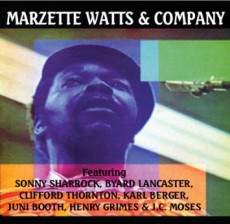
Daily Dose Of Jazz…
Marzette Watts was born March 9, 1938 in Montgomery, Alabama. Early in his life he played piano but did not play regularly in his teens. While studying at Alabama State College he became a founding member of SNCC, however, this association led to his being forced to leave the state at the behest of the governor.
He moved to New York, where he lived in a loft building on Cooper Square where Leroi Jones aka Amiri Barak lived and with whom he participated in the Organization of Young Men.. Watts returned to college in New York, completing his studies in 1962; and then moved to Paris to study painting at the Sorbonne and began playing saxophone for extra money.
Returning to New York in 1963, Marzette studied under Don Cherry, played in his loft and around the city with Juini Booth, Henry Grimes, J.C. Moses, and others. He also continued painting, producing work strongly influenced by Willem de Kooning. His loft attracted many established and up-and-coming musicians who would hang out there and play at parties, including Ornette Coleman, Cecil Taylor, Don Cherry, Archie Shepp and Pharoah Sanders.
By 1965 he devoted himself to music more fully, moved to Denmark for further study. Moving back and forth between Europe and New York City, while in New York he recorded an album for ESP-Disk and another for Savoy Records, and aught briefly at Wesleyan University.
He wrote film scores and did production work for his own films, eventually abandoning music to work in film and record production. Late in his life he moved to Santa Cruz, California but free jazz tenor and soprano saxophonist, bass clarinetist and sound engineer Marzette Watts passed away in Nashville, Tennessee of heart failure on March 2, 1998.
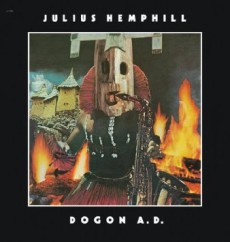
Daily Dose Of Jazz…
Julius Arthur Hemphill was born on January 24, 1938 in Fort Worth, Texas and attended M. Terrell High School, studied clarinet with John Carter before taking up the saxophone due to the early influence of Gerry Mulligan.
Hemphill joined the Army in 1964, served for several years, and later, for a brief period, performed with Ike Turner. In 1968 he moved to St. Louis, Missouri and co-founded the multidisciplinary arts collective. This brought together saxophonists Oliver Lake and Hamiet Bluiett, trumpeters Baikida Carroll and Floyd LeFlore and writer/director Malinke Robert Elliott.
A move to New York City in the mid-1970s witnessed Julius thriving in the free jazz community. He gave saxophone lessons to David Sanborn, and Tim Berne among others. He founded the World Saxophone Quartet in 1976 after collaboration with Anthony Braxton. He remained a member until the early 1990s and then formed a saxophone quintet.
Hemphill recorded over twenty albums as a leader and another ten records with the World Saxophone Quartet and recorded or performed with Bjork, Bill Frisell, Jean-Pau Bourelly and others. Late in his life his ill-health including diabetes and heart surgery, forced Hemphill to stop playing saxophone, but he continued writing music. His saxophone sextet, led by Marty Ehrlich, also released several albums of Hemphill’s music, but without Hemphill playing. The most recent is entitled The Hard Blues, posthumously recorded live in Lisbon.
Prior to his death on April 2, 1995 in new York City, composer and alto saxophonist and flautist recorded a multi-hour interview on his life and music for the Smithsonian Institute and it is held at the archive center of the National Museum of American History in Washington D.C.


